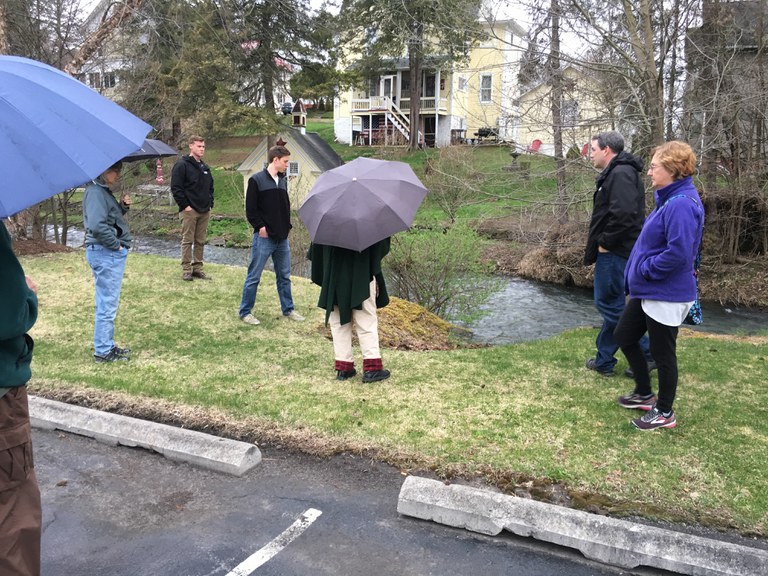Posted: May 4, 2018
AEC student interns conducted a homeowner's stormwater workshop in Bellefonte, PA.
Rain came steadily at times and the umbrellas were out. But the questions and conservation kept coming.
These residents were in their element. They were here to learn about how to better manage stormwater on their properties.
On April 24, AEC interns Sean Bernheisel and Bill Ryan presented a stormwater workshop at the American Philatelic Society in Bellefonte. The workshop was developed in partnership with the Bellefonte Borough and as a project of the Penn State Sustainability Institute's Sustainable Communities Collaborative.
In December 2017, SCC Coordinator Ilona Ballreich and AEC's Anna Marie Nachman met with Don Holderman, Assistant Borough Manager of Bellefonte to assess possible locations for the workshop. The Borough has been active in recent years to develop programs and solutions to address impacts from stormwater runoff.
One area where the AEC could help was to educate homeowners. Holderman worked with AEC staff and students to design a public workshop. The American Philatelic Society agreed to provide a location.
The workshop curriculum was based on the Homeowner's Guide to Stormwater, that was developed several years ago by the AEC and other partners working in the Little Conestoga watershed in Lancaster County.
Sean and Bill planned the workshop agenda while another AEC intern, Aidan Tierney, wrote promotional materials that were shared with the Borough and disseminated to residents through its spring newsletter. Co-sponsors were also recruited and along with the Borough and the Sustainability Institute included the Spring Creek Chapter of Trout Unlimited, Clearwater Conservancy, and the Spring Creek Watershed Commission.
The workshop began with a presentation by Bill and Sean that explained stormwater runoff and its impacts, and included the several relatively simple management practices which are highlighted in the guide: rain gardens, native meadows, tree planting, rain barrels, pervious pavers, and--for those with streamside property--riparian buffers.
The group then went outside to brave the elements and see stormwater runoff in action. While the redeveloped commercial property was much different than most residential settings, it did provide opportunities to explore the same stormwater issues that may exist at home: areas of concentrate flow, downspouts directed to underground storm sewers, mowing to the edge of streams, and runoff from sloped impervious surfaces like driveways and parking areas.
Workshop participants learned how to recognize these areas, and how to use the guide to develop a plan for addressing them. A swale on the property where stormwater flows during heavy rains might be a good place to concentrate native wildflower plantings. A downspout coming from a portion of a roof could be redirected toward a rain garden. If an outdoor patio expansion is in your plans, consider pervious pavers. A rain barrel can help provide water all summer long for your flower garden. No longer mowing to the stream's edge and planting some trees there instead can help slow bank erosion.
Back inside from the rain, participants gathered around a site map of the property and drew potential stormwater management solutions.
"The workshop was a rewarding experience," said Bill. "It was just a pleasure to meet people who are passionate about sustainability and about making a difference in their own community."
All participants left the workshop with copies of the stormwater guide and with new found knowledge on how to develop their own stormwater management plan for their own properties.
To download a print copy of the guide, or to use the interactive web-based tool complete with videos, visit www.stormwaterguide.org.


